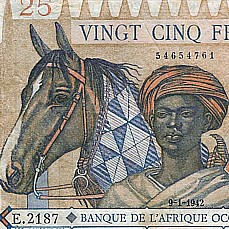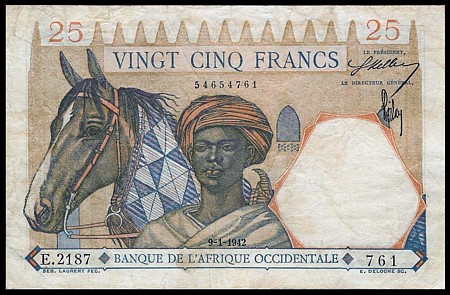FRENCH WEST AFRICA 25 Francs
Tuareg Horsemen

The Touareg people are descendants of the Garamantian Empire in Sahara, and part of the indigenous Berber people in North Africa. They have an ancient nomadic history in which they were strong participants of the Saharan Caravan Trade across the Sahara desert trading with Mediterranean countries and Sub Saharan cities. The Touareg still inhabit Northern and Western Africa. Around 500 AD the Touareg expanded south into an area known as the Sahel, where the Sahara changes from the desert into the grassy savannas, scrubland and woods.
A Touareg legend states that their first leader was a woman called Tin Hinan, who established a federation of the tribes in the Ahaggar Mountains in southern Algeria. She was so revered that she was known as ‘Our Mother’ among the Touareg. Until the French began their scramble for Africa and colonized the area, the Touareg existed in such loose organizations of tribes, each with a regional leader.
The distinctive deep blue turban worn by the adult Touareg males is known as a ‘tagelmust’. It actually is one piece of cloth measuring about 33 feet in length, and is used as both a turban and a veil. The tagelmust has been traditionally died an indigo color, which can leach into the skin, leading the Touareg to be called the ‘Blue Men of the Desert”. It is an important aspect of Touareg society, with many distinct uses. It not only protects the head from the sun, and the face from the desert sands, but it also serves as a means of social modesty and respect. The tagelmust is removed only in the home and among family. The veil also serves to hide the face from strangers, which is common practice among Touareg males. While blue is the traditional color, and is reserved for their celebrations, other colors have been making their way into the Touareg culture, such as the red color depicted in the young man on this banknote.
The Touareg used to hold slaves in their society, and used the slaves to work as herders and for other menial tasks. The practice was frowned upon by the French when they colonized the area, but there was no little effort to end it. Martin Klein estimated in his book Slavery and Colonial Rule in French West Africa(1998) that there was estimated 50% of the population in French Controlled Sudan that were slaves. This estimate shows that slavery was so ingrained into society, that to end the practice suddenly would likely have caused widespread rebellion among the populace, which of course the French occupiers did not want. So instead acts were passed which abolished slavery, but there was no effort to enforce the new law.
During the French occupation of Africa, the Touareg were not allowed to exist in their traditional loosely governed communities, which were seen as too separate and independent from their control. Instead, the Touareg were subjected to a western style of governance by the French Colonial Administrators. As a result, the French encountered many battles with the strongly independent Touareg, much of it in the Ahaggar Mountain region in southern Algeria. One leader was able to broker a peace between the French in the Sahara. Moussa ag Amastan met with Captain Metois in January 1904, and was given a written agreement that the French did not want to have the Touareg as their subjects, only to create conditions in which the French could peaceably exist in the area. The agreement was made, but the truth was, of course another thing altogether. The French were there to occupy the lands, and to rule the people. They were no longer just Touareg; they were French subjects.
When much of Africa became independent of their colonial rule in the 1960’s, the independence set firm boundaries throughout the countries and divided, and thus restricted, the lands that many tribes had long inhabited. The Touareg became a divided people, and conflicts between the Touareg and the new governments of these stronger bordered countries were encountered. The nomadic tradition they enjoyed was now severely limited and their herding lifestyle has been challenged in their new countries including Mali, Niger, and Libya, Morocco, Algeria and Burkina Faso.
It took no time at all for a rebellion to occur in Mali. The Touareg Uprising took place mainly in Northern Mali where most of the Touareg lived. The newly formed Malian armies fought with the Touareg and were focused on military action on all Touareg, not just those who were rebelling. As a result, many Touareg fled into Niger, where there was no rebellion. The uprising lasted from 1961-1964 when the Army finally suppressed the rebels.
But Niger would not be exempt from Touareg restlessness. Another uprising occurred in both Mali and Niger in 1990. This rebellion was an attempt to separate and form an independent nation. Mali was able to achieve a peace agreement in 1992, but Niger had to endure violence until 1994. When peace was finally achieved, there were to be less governmental regulations for the Touareg and their warriors would be allowed to join the armies of Niger or Mali.
But then in 2007 Mali and Niger both had attacks from Touareg groups who were not receiving their promised integration into the government and military service as promised. Several peace deals have again been made, but they are seemingly only temporary, as the Touareg and their governing officials continually refuse to see eye to eye on their issues. The Touareg’s deeply ingrained history of nomadic herding and trading simply refuses to be suppressed.
A Touareg horseman is featured on the front of this 25 franc banknote issued in 1942.

